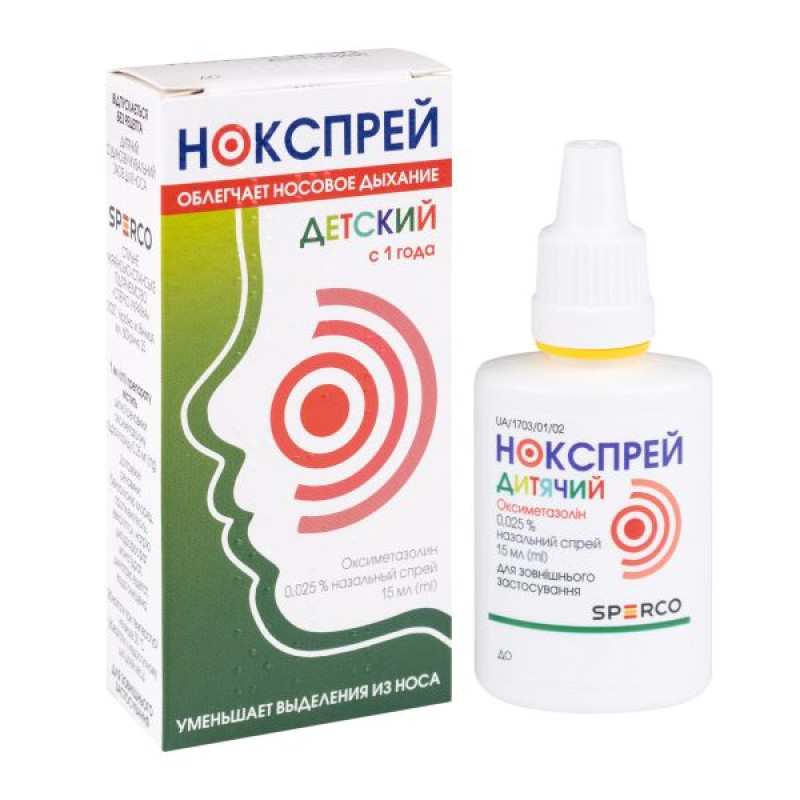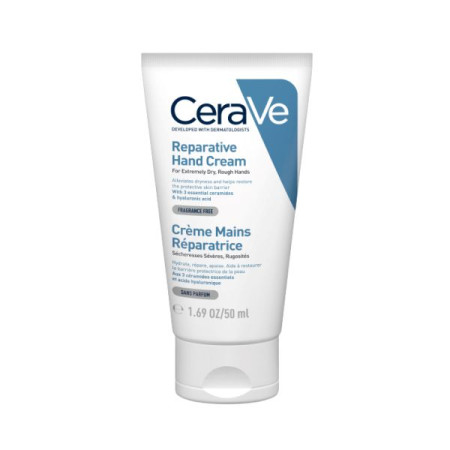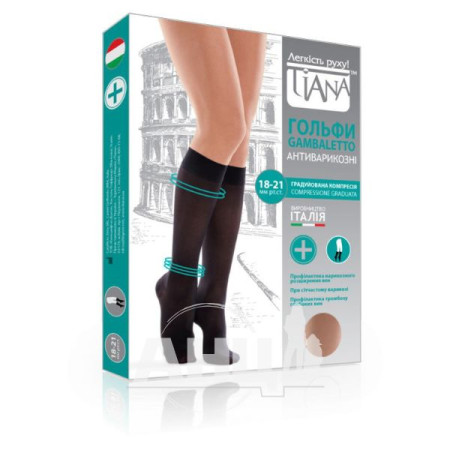Noxspray children's nasal spray 0.025% container 15 ml

Instructions for use Noxspray children's nasal spray 0.025% container 15 ml
Composition
active ingredient: oxymetazoline;
1 ml of the drug contains oxymetazoline hydrochloride 0.25 mg;
Excipients: benzalkonium chloride, propylene glycol, eucalyptol, sodium dihydrogen phosphate monohydrate, disodium edetate, purified water.
Dosage form
Nasal spray.
Main physicochemical properties: colorless or slightly yellowish transparent liquid with a specific odor.
Pharmacotherapeutic group
Anti-edematous and other drugs for topical use in case of diseases of the nasal cavity. Sympathomimetics, simple drugs.
ATX code R01A A05.
Pharmacological properties
Pharmacodynamics
Noxspray for children is an α-adrenomimetic, an imidazoline derivative, belonging to the group of local vasoconstrictors. It constricts blood vessels at the site of application, reduces swelling of the nasal mucosa and upper respiratory tract, reduces nasal discharge. Restores nasal breathing. Elimination of swelling of the nasal mucosa contributes to the restoration of aeration of the paranasal sinuses and middle ear cavity, which prevents the development of bacterial complications. Oxymetazoline has antiviral, anti-inflammatory, immunomodulatory and antioxidant effects. Thanks to this combined mechanism of action, faster and more effective elimination of symptoms of acute rhinitis (nasal congestion, rhinorrhea, sneezing, poor health) was observed. When applied topically to the nose in therapeutic concentrations, it does not irritate the nasal mucosa, does not cause hyperemia. The essential oils that make up the preparation help eliminate the feeling of irritation of the nasal mucosa, protect it from excessive drying.
Pharmacokinetics
The half-life is about 35 hours after administration. 2.1% of the drug is excreted by the kidneys, about 1.1% - with feces. The duration of action of oxymetazoline is up to 12 hours.
Indication
acute rhinitis; allergic rhinitis; attacks of non-infectious vasomotor rhinitis; to restore drainage and nasal breathing in diseases of the paranasal sinuses of the nasal cavity, eustachitis associated with rhinitis; to eliminate edema before diagnostic manipulations in the nasal passages.
Contraindication
Hypersensitivity to the components of the drug, atrophic rhinitis, when using monoamine oxidase inhibitors (MAO) and within 2 weeks after stopping treatment with MAO inhibitors, as well as other drugs that cause an increase in blood pressure, with increased intraocular pressure, especially with angle-closure glaucoma, with severe forms of cardiovascular diseases (e.g., ischemic heart disease, arterial hypertension), pheochromocytoma, metabolic disorders (hyperthyroidism, diabetes mellitus, porphyria), prostatic hypertrophy. Do not use after transsphenoidal hypophysectomy or other surgical interventions with exposure of the meninges.
Interaction with other medicinal products and other types of interactions
The drug should not be used simultaneously with other local vasoconstrictors and intranasally administered agents (increased incidence of adverse reactions), with MAO inhibitors of the tranylcypromine type, tricyclic antidepressants and other agents that cause an increase in blood pressure due to the risk of arterial hypertension.
Application features
Insert the tip of the bottle nozzle into each nasal passage and press the bottle sharply once. During the injection, draw air through your nose. Do not tilt your head back and turn the bottle over when injecting Noxspray for children (the bottle should be held strictly vertically). To prevent the spread of infection, do not use one bottle for several people.
Long-term use and overdose of the drug should be avoided. Long-term use of a nasal decongestant may lead to a weakening of the drug's effect. Abuse of this drug may cause atrophic rhinitis, mucosal atrophy, and reactive hyperemia with drug-induced rhinitis. After using the drug, special observation is necessary for patients with chronic rhinitis and in the case of edema removal before diagnostic procedures. Doses higher than recommended should be used only under the supervision of a physician.
Ability to influence reaction speed when driving vehicles or other mechanisms
After prolonged use of the drug in doses exceeding the recommended ones, a general effect on the cardiovascular and nervous systems cannot be excluded. In such cases, the ability to drive may be impaired.
Use during pregnancy or breastfeeding
Data on the effects of the original oxymetazoline in a limited number of women in the first trimester of pregnancy do not indicate the development of adverse reactions that would affect the course of pregnancy or the health of the fetus/newborn. Other epidemiological data are not available to date. Animal studies have shown reproductive toxicity at doses exceeding therapeutic doses. The drug should be used with caution during pregnancy only after a careful assessment of the risk to the fetus and the benefit to the mother. During pregnancy, the recommended dosage should not be exceeded, as overdose may impair the blood supply to the fetus.
Data on the penetration of oxymetazoline into breast milk are unknown. The drug should be used during breastfeeding only if the benefit/risk ratio is carefully assessed. During breastfeeding, the recommended dosage should not be exceeded, as an overdose may reduce the amount of breast milk in the mother.
Method of administration and doses
Children aged 1 to 6 years - 1 spray in each nasal passage 2-3 times a day. A single dose should not be used more than 3 times a day and for longer than 7 days. Do not use doses higher than recommended.
Children
Noxspray for children should be prescribed to children aged 1 to 6 years.
Overdose
Overdose may occur after nasal or accidental oral administration. The clinical picture of intoxication with imidazole derivatives may be unclear, since periods of stimulation may alternate with periods of depression of the central nervous, cardiovascular and respiratory systems.
Central nervous system stimulation may manifest as anxiety, agitation, hallucinations, and seizures.
Central nervous system depression may manifest as decreased body temperature, lethargy, drowsiness, and possible coma.
The following symptoms may also occur: miosis, mydriasis, fever, increased sweating, pallor, cyanosis, rapid heartbeat, tachycardia, bradycardia, arrhythmia, cardiac arrest, arterial hypertension, arterial hypotension up to the development of shock, nausea, vomiting, respiratory failure and apnea, mental disorders.
In particular, in children, overdose may cause mainly central nervous system effects: convulsions and development of coma, bradycardia, apnea, as well as arterial hypertension with a possible transition to arterial hypotension.
Treatment. In cases of severe overdose, intensive care is indicated. Immediate administration of activated charcoal (absorbent), sodium sulfate (laxative) or gastric lavage (in case of overdose with a large amount of the drug) is recommended, since oxymetazoline can be rapidly absorbed. The use of vasopressors is contraindicated. Non-selective alpha-blockers can be used as an antidote. If necessary, measures can be taken to reduce body temperature, carry out anticonvulsant therapy and ventilation of the lungs.
Adverse reactions
Respiratory system: nasal discomfort, burning or dryness of the nasal mucosa, feeling of severe nasal congestion (reactive hyperemia), sneezing, nosebleeds, apnea in newborns and young children, especially in case of overdose.
From the nervous system: headache, drowsiness, fatigue, lethargy, insomnia, anxiety, convulsions (especially in children), hallucinations (especially in children), dizziness, nausea, vomiting.
Cardiovascular system: topical nasal application of the drug may cause systemic effects (palpitation, tachycardia, arterial hypertension, arrhythmias).
On the part of the immune system: allergic reactions are possible, including rash, itching, angioedema.
Expiration date
2 years.
Do not use the drug after the expiration date indicated on the package.
Storage conditions
Store at a temperature not exceeding 30 ° C. Keep out of the reach of children.
Packaging
15 ml in polymer containers with spray stoppers and tamper-evident caps in a cardboard pack.
Vacation category
Without a prescription.
Producer
Joint Ukrainian-Spanish enterprise "Sperco Ukraine".
Location of the manufacturer and its business address
21027, Ukraine, Vinnytsia, 600-anniversary St., 25.
There are no reviews for this product.
There are no reviews for this product, be the first to leave your review.
No questions about this product, be the first and ask your question.















